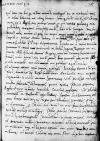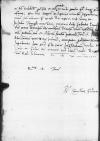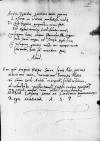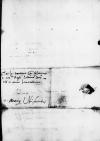List #1103
Camillo GHILINO do Ioannes DANTISCUSBrussels, 1534-01-25
| odebrano [1534]-03-07 Rękopiśmienne podstawy źródłowe:
Pomocnicze podstawy źródłowe:
Publikacje:
| ||||||||||||||
Tekst + aparat krytyczny + komentarz Zwykły tekst Tekst + komentarz Tekst + aparat krytyczny
Reverendissimo Domino
Ubi fuerit
Dantisco, viro clarissimo, plurimam salutem.
Quam laetor ex his, qui istinc veniunt, intellegere te et valentem esse et solita hilaritate uti otiio overwritten⌈oo overwritten⌉que litterario summeque factum divitem non Stoicorum more, sed a regibus tuis prolixe acceptum et ut virtus probitasque tua postulabat, maximis sacerdotiis auctum. Haec tibi incepta Deus fortunaret, volo. Moriar, si quicquam hoc tempore magis cuperem quam apud te triduo esse, hospitem enim minime edacem haberes, sed multilocumorum paper damaged⌈[ilocumorum overwritten⌈orumorum overwritten⌉]ilocumorum paper damaged⌉(?) verborum superinscribed⌈verborumverborum superinscribed⌉, plura quippe essent quod communibus studiis, quae de re publica disputaremus. probably
Quod ad rem publicam attinet, rerum capita perstringam.  AAWO, AB, D. 3, f. 94v
in diem trahebantur. Quid quaeris et Tibi gratulor superinscribed⌈gratulorgratulor superinscribed⌉ et mihi gau written over ra⌈raauau written over ra⌉deo, quod longe gentium absimus. Huc bre<v>i
AAWO, AB, D. 3, f. 94v
in diem trahebantur. Quid quaeris et Tibi gratulor superinscribed⌈gratulorgratulor superinscribed⌉ et mihi gau written over ra⌈raauau written over ra⌉deo, quod longe gentium absimus. Huc bre<v>i
In
Reverendissimae Dominationis Tuae servitor ... illegible⌈...... illegible⌉
luserat in vitreis ambitiosa vadis
et caelo fugiens, properantis nescia fati
est aquilas dominae ludificata meae;
consequor hanc, sensim praetervolat illa superne,
insto iterum, magni ad templa superba Iovis.
Cum resupina gemens rostro me excepit acuto
incautam, fato sum moritura pari.
Aliud
Haec, quam suspicis hospes sacraAlbissimis rara, rarissimae principis delicias
Dum summo caelo ardeam insequitur, infelix fatum
Ab reluctante rostro tandem superba cadens excipitur
Atque simul ambae uno ictu occidunt,
Maria
regis matrona.
A(mico) S(uo) P(raestantissimo)



